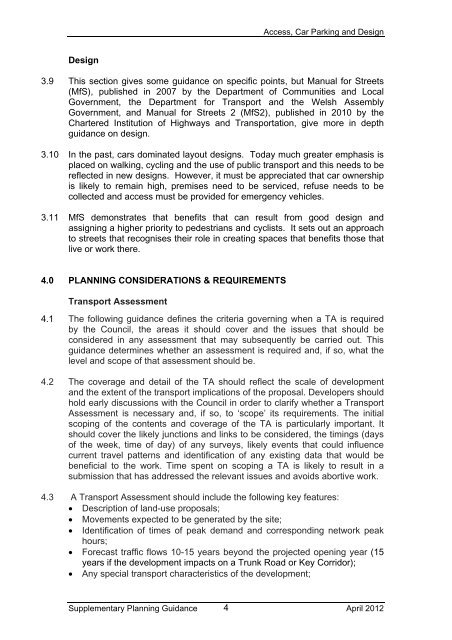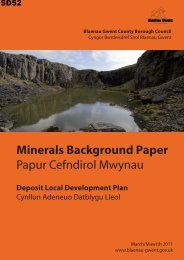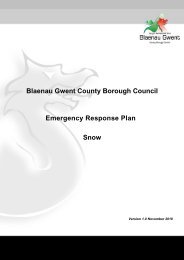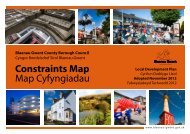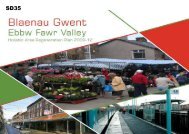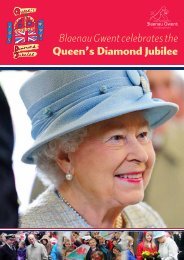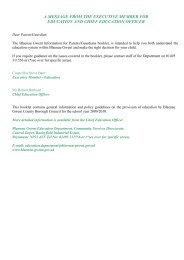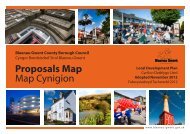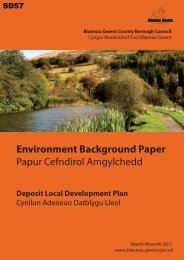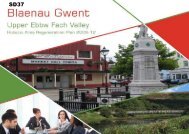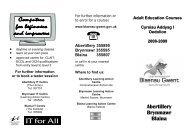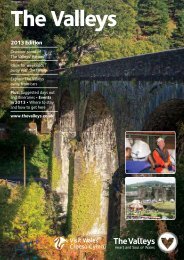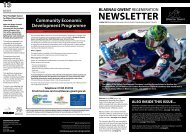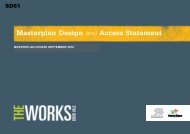Access Car Parking & Design - Blaenau Gwent County Borough ...
Access Car Parking & Design - Blaenau Gwent County Borough ...
Access Car Parking & Design - Blaenau Gwent County Borough ...
Create successful ePaper yourself
Turn your PDF publications into a flip-book with our unique Google optimized e-Paper software.
<strong>Access</strong>, <strong>Car</strong> <strong>Parking</strong> and <strong>Design</strong><br />
<strong>Design</strong><br />
3.9 This section gives some guidance on specific points, but Manual for Streets<br />
(MfS), published in 2007 by the Department of Communities and Local<br />
Government, the Department for Transport and the Welsh Assembly<br />
Government, and Manual for Streets 2 (MfS2), published in 2010 by the<br />
Chartered Institution of Highways and Transportation, give more in depth<br />
guidance on design.<br />
3.10 In the past, cars dominated layout designs. Today much greater emphasis is<br />
placed on walking, cycling and the use of public transport and this needs to be<br />
reflected in new designs. However, it must be appreciated that car ownership<br />
is likely to remain high, premises need to be serviced, refuse needs to be<br />
collected and access must be provided for emergency vehicles.<br />
3.11 MfS demonstrates that benefits that can result from good design and<br />
assigning a higher priority to pedestrians and cyclists. It sets out an approach<br />
to streets that recognises their role in creating spaces that benefits those that<br />
live or work there.<br />
4.0 PLANNING CONSIDERATIONS & REQUIREMENTS<br />
Transport Assessment<br />
4.1 The following guidance defines the criteria governing when a TA is required<br />
by the Council, the areas it should cover and the issues that should be<br />
considered in any assessment that may subsequently be carried out. This<br />
guidance determines whether an assessment is required and, if so, what the<br />
level and scope of that assessment should be.<br />
4.2 The coverage and detail of the TA should reflect the scale of development<br />
and the extent of the transport implications of the proposal. Developers should<br />
hold early discussions with the Council in order to clarify whether a Transport<br />
Assessment is necessary and, if so, to ‘scope’ its requirements. The initial<br />
scoping of the contents and coverage of the TA is particularly important. It<br />
should cover the likely junctions and links to be considered, the timings (days<br />
of the week, time of day) of any surveys, likely events that could influence<br />
current travel patterns and identification of any existing data that would be<br />
beneficial to the work. Time spent on scoping a TA is likely to result in a<br />
submission that has addressed the relevant issues and avoids abortive work.<br />
4.3 A Transport Assessment should include the following key features:<br />
Description of land-use proposals;<br />
Movements expected to be generated by the site;<br />
Identification of times of peak demand and corresponding network peak<br />
hours;<br />
Forecast traffic flows 10-15 years beyond the projected opening year (15<br />
years if the development impacts on a Trunk Road or Key Corridor);<br />
Any special transport characteristics of the development;<br />
Supplementary Planning Guidance 4<br />
April 2012


